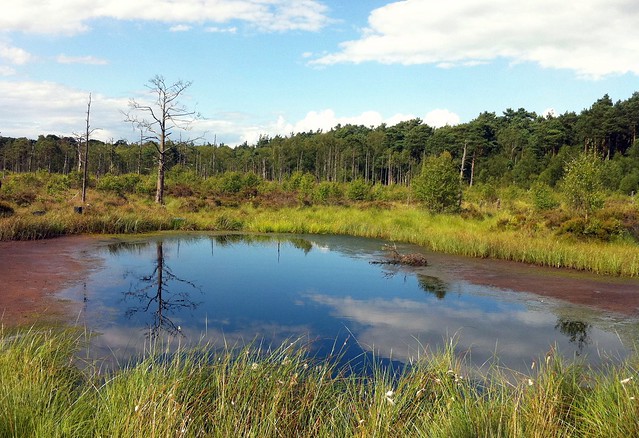By Paul Williams, Assistant Producer, Animals Guide to Britain
With thanks to Mel Brown of Natural England & Claire Install of the British Dragonfly Society.
One of the most enchanting emblems of the British summer is the dragonfly, and we are lucky to have 25 resident breeding species, and 9 who occasionally pop over from Europe when the weather is good. One of the top spots to see these is the peculiar landscape of a Shwingmoor bog, hidden deep in the heart of Staffordshire. Local mythology speaks of water beasts dragging people to their death, but the real reason this reserve is out of bounds for the casual visitor is hidden beneath a gentle carpet of carnivorous plants, cranberries, cowberries and bilberries. This is Chartley Moss, and what makes it a Shwingmoor is that you can literally walk on water - or more accurately on a 3 metre layer of saturated peat and Sphagnum which floats on top of a 15 metre deep lake. Here 23 species of dragonflies have been recorded including some of the rarest in Britain. I recently visited Chartley Moss to film dragonflies for 'Animals Guide to Britain'.

Chartley Moss, a Shwingmoor Bog in Staffordshire
The Lost World Beneath
Laden with tripods and heavy cases, we cautiously stepped onto the bog, every step creating a ripple and a squelch. I stopped to rest and immediately my feet started to sink into the quagmire. As I began to move away my boot decided that it wanted to stay a little longer - it had been only five minutes and already my welly had succumbed to the beast. We were heading towards the centre, where the peat was at its thinnest and where two large pools puncture the spongey layer to offer a glimpse into the lost world beneath. It is here that we were most likely to find dragonflies as the watery underworld is their true domain. It is the dragonfly nymph who lives here, and this aquatic period of a dragonfly's life dictates when and where the adults are to be found. Nymphs of different species prefer different watery habitats, from sheltered woodland pools to slow flowing rivers and canals. Chartley Moss is particularly famous as the most southern site of the White-faced Darter. Its nymph is critically dependant on lowland acidic peat bogs - 95% of which have been lost in the past 40 years, leaving only a handful of sites for this dainty dragonfly to cling to.

The rare White-Faced Darter
The Creature Breaks Free
Lurking in the muddy bottom of a pond it can take nymphs up to five years to realise that there's more to life that sucking on tadpole juice, and they start to leave the comfort of the water. This is the moment that we had come to film. As we arrived, with soggy feet, a small army of nymphs of the Common Hawker were making the epic journey up the reeds which lined the pools. We watched as their spindly legs strenuously pulled them out of the water, driven by an urge that goes back 320 million years to the earliest dragonflies. We could see the determination as they fell off, only to repeat the climb in a bid to feel the warm morning sun. Then the intimate moment of transformation as they settled into position and froze. The skin cracked and opened. Two iridescent green eyes peered out from within as slowly the head of an adult pushed its way out of the nymph capsule. In just a few minutes the subaqua suit had been shed to reveal a new creature resplendent in dragonfly finery.

Common Hawker emerging from its Nymph
Sex Fuelled Crescendo
Under the boggy water they had propelled themselves by jet power, squirting water from their backsides, but as we filmed, their green wings slowly opened and inflated until eventually they took to the air as a squadron of dynamic highly agile flying machines. They had reached the sex-fuelled crescendo of a life lived under the water and now their airborne mission was to locate a mate and lay eggs back into the water. Live fast, die young, they would have only a few months in which to accomplish their mission. We had achieved ours in just a few hours.

Common Hawker preparing for its first flight
Chartley Moss is privately owned and leased to English Nature. It is a very fragile and extremely hazardous site. Access is by permit only.
For more information:
Natural England
BBC Breathing Places
'Animals Guide to Britain' presented by Chris Packham will be broadcast on BBC2 in April 2011.
Get the flash player here: http://www.adobe.com/flashplayer
No comments:
Post a Comment